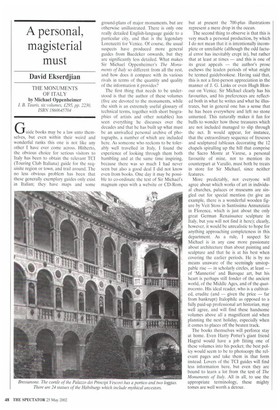A personal, magisterial must
David Ekserdjian
Guide books may be a law unto themselves, but even within their weird and wonderful ranks this one is not like any other I have ever come across. Hitherto, the obvious choice for serious visitors to Italy has been to obtain the relevant TO (Touring Club Italiana) guide for the requisite region or town, and trail around. The no less obvious problem has been that these generally exemplary guides only exist in Italian; they have maps and some
ground-plans of major monuments, but are otherwise unillustrated. There is only one really detailed English-language guide to a particular city, and that is the legendary Lorenzetti for Venice. Of course, the usual suspects have produced more general guides from Baedeker onwards, but they are significantly less detailed. What makes Sir Michael Oppenheimer's The Monuments of Italy so different from all the rest, and how does it compare with its various rivals in terms of the quantity and quality of the information it provides?
The first thing that needs to be understood is that the author of these volumes (five are devoted to the monuments, while the sixth is an extremely useful glossary of technical terms, together with short biographies of artists and other notables) has seen everything he discusses over the decades and that he has built up what must be an unrivalled personal archive of photographs, a number of which are included here. As someone who reckons to be tolerably well travelled in Italy, I found the experience of looking through them both humbling and at the same time inspiring, because there was so much I had never seen but also a good deal I did not know even from books. One day it may be possible to co-ordinate the text of Sir Michael's magnum opus with a website or CD-Rom, but at present the 700-plus illustrations represent a mere drop in the ocean.
The second thing to observe is that this is very much a personal production, by which I do not mean that it is intentionally incomplete or unreliable (although the odd factual error has inevitably crept in), but rather that at least at times and this is one of its great appeals — the author's prose eschews the leaden periods of what might be termed guidebookese. Having said that, this is not a first-person appreciation in the manner of J. G. Links or even Hugh Honour on Venice. Sir Michael clearly has his favourites, and his preferences are reflected both in what he writes and what he illustrates, but in general one has a sense that he has been everywhere and left no stone unturned. This naturally makes it fun for buffs to wonder how those treasures which are not included managed to slip through the net. It would appear, for instance, that the extraordinary sequence of frescoes and sculptured tableaux decorating the 12 chapels spiralling up the hill that comprise the Sacro Monte at Varese, a personal favourite of mine, not to mention its counterpart at Varallo, must both be treats in store for Sir Michael, since neither features.
More predictably, not everyone will agree about which works of art in individual churches, palaces or museums are singled out for special mention (to give an example, there is a wonderful wooden figure by Veit Stoss in Santissima Annunziata in Florence, which is just about the only great German Renaissance sculpture in Italy, but you will not find it here); clearly, however, it would be unrealistic to hope for anything approaching completeness in this department. As a rule, I suspect Sir Michael is in any case more passionate about architecture than about painting and sculpture and that he is at his best when covering the earlier periods. He is by no means unaware of the seemingly unstoppable rise — in scholarly circles, at least — of 'Mannerist' and Baroque art, but his heart is perhaps still fonder of the ancient world, of the Middle Ages, and of the quattrocento. His ideal reader, who is a cultivated, erudite (and — given the price — far from bankrupt) Italophile as opposed to a fully paid-up professional art historian, may well agree, and will find these handsome volumes above all a magnificent aid when planning the next holiday, especially when it comes to places off the beaten track.
The books themselves will perforce stay at home. Even Harry Potter's giant friend Hagrid would have a job fitting one of these volumes into his pocket; the best policy would seem to be to photocopy the relevant pages and take them in that form instead. Lovers of the TCI guides will find less information here, but even they are bound to learn a lot from the text of The Monuments of Italy. All in all, to use the appropriate terminology, these mighty tomes are well worth a detour.






















































































 Previous page
Previous page